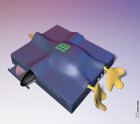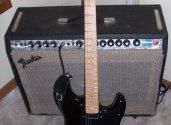My 1972 Fender Twin Reverb
Introduction
God gave me this wonderful amp while I was stationed in South Korea. Cost me only $300 used. It had been modified with Celestion Modern Lead speakers. I replaced these with Celestion Classic Lead speakers. Click the picture above for a bigger picture.Just How Loud Is It?
This baby has two 12" speakers and (if I can believe what I see on the internet) it's 85 watts. Now that sounds small, until you realize that it's a tube amp. I was told once, for example, that at master volume 7 I was heard above everything in our church auditorium, from behind a wall on the platform! And it was the sound tech on the other side of the auditorium that wasn't happy!But the tone is what I like. It has vibrato and spring reverb, both of which sound great. But it's one of the cleanest sounding, if not the cleanest sounding, tube amps I've ever heard! I run my Fender Lite Ash Stratocaster and Fender Showmaster FAT HH into it, as well as my Boss ME-50, and it has plenty of power for my uses.
What Are Your Settings?
I've noticed several things about how to set up certain guitars for use on this amp. First, make sure you remember that the "1" jack is for the default Fender guitar, usually meaning something with single coil pickups and/or 250k potentiometers. This includes the Stratocaster and the Telecaster. The "2" jack is for more powerful guitars with 500k potentiometers (usually those that have humbuckers). This is so that the sound is even if, say, you're playing your Strat and your friend wants to plug in his Les Paul. Anyways, I've noticed that if you want clean, just set the master volume to five and the channel volume to whatever sounds good to you. It's possible to achieve an overdrive sound on the Twin Reverbs that have a Master Volume by doing the opposite: by running channel volume at max and then master volume to taste. My EQ is usually treble/mid/bass 5/3/3 because my Lite Ash Stratocaster has Alnico II Pro pickups, which are more bassy and midrangey, and less bright, than the stock Fender alnico V magnets. However, I've been able to get a more "default" tube amp sound by running all 5's on my EQ with this guitar and then putting the channel volume down a bit low (3-4) with the master volume a bit high (6-7). I prefer the EQ at all 5's and to adjust the channel and master volume so that I get more of an "organic" tube amp sound. I prefer cleans to have absolutely no crunch in any frequency.You may also run into issues with getting this amp to crunch, or go overdrive. This is actually normal. The Twin Reverb was meant to be very clean. You can overdrive it, but you're damaging the amp a bit more by doing this. This is why overdrive and distortion pedals were made, so buy one and use it. A Blues Driver can saturate one of these very nicely, as can a Tube Screamer. From there, if you want metal, get a Metal box of your choice. This amp sounds good with a metal distortion pedal in front of it, trust me.
What About '65 Fender Twin Reverb Reissues (Brand New)?
I played a brand new '65 reissue during a concern, and I was impressed at how loud and clean they are! They're also worthy of purchasing. However, they seem to be modeled against Blackface cosmetics and wattage. They are very loud and punchy, so achieving natural overdrive should be very easy, albeit I don't remember them having a master volume. I could be wrong.Church 2006
Here are some clips. I'm working on my technical abilities, so please be fair. I was playing an ESP LTD EC-100QM with the Seymour Duncan Hot Rodded combination in it. Sure, the vocals are high, and it's not the best environment, but I was playing lead guitar through this amp, so I offer the clips:- Clip 1: Hosanna, intro soloing
- Clip2: Hosanna, soloing
- Clip3: I Will Boast, intro
power riffs (oops on the octave bend)
- Clip 4: I Will Boast, soloing
around for fun
Sale
I decided to sell it when moving after
retiring from the military because I didn't think I'd have the
room to use it. I had bought a Roland keyboard amp.
This was probably a mistake, but the person who bought it was a
touring musician, so I think it went to a good home.





